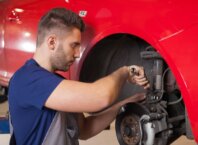The pandemic that unexpectedly ruined our plans and the global economy in 2020 is still a huge problem in many parts of the world. Even when the ever-growing numbers of Covid-19 cases are gone for good, we already know that certain aspects of life have been changed forever. Some industries may never be the way they were before.
How has Covid-19 and its implications influenced the automotive and transportation sector? There are numerous interesting studies and observations on how people’s behaviour changed, what businesses thrived and which ones suffered the most, what environmental benefits came along and more. Read the 2020 review for the car and transportation sector and find out how COVID-19 affected us, our vehicles and the industry as a whole.
Public transport during the pandemic
First of all, we could observe a worldwide decrease in the use of public transport. The exact numbers vary between countries, but the change is overwhelming.
In the US, the use of public transport dropped by 36%. In Germany, the decrease rate was 48%, while in China and Japan – an astounding 58%. Social distancing was clearly the contributing factor here; people would choose their cars or even bicycles more often than before the outbreak, simply out of fear of getting infected when in the proximity of others.
Passenger car use during the pandemic
The past year saw us change the way we use our cars, too. Hardly anyone thought of grocery shopping from the comfort (and safety) of their vehicle before 2020. Now, in addition to that possibility, we had novelties like drive-through COVID-19 testing sites.
We also had to forget about eating out the way we used to. As the home-bound wanted to order food from the restaurants, takeaways boomed with more and more cars, bikes and bicycles driven by couriers. Businesses like Uber Eats dominated the market and took their “pound of flesh”, charging restaurants up to 30% commission for each order on top of the fees paid by the hungry customers.
Another significant change in the way we use our cars post-outbreak is that we simply don’t drive that often anymore. The domination of home office meant that the daily commute was reduced to trips from the bedroom to the study. There are hardly any school runs anymore as kids stay home and study in the comfort, or discomfort, of their rooms.
Some people still drive, whether to run errands that cannot be treated online, because their jobs require their physical presence or to visit and support families during these hard times. These days, however, we now drive alone in the car when going on such trips. Naturally, neither motorists nor passengers are keen on any car sharing services which were becoming very popular before the pandemic started.

Road safety during the pandemic
Half-empty streets resulted in an overall reduced number of road traffic accidents, however, in many cases, fatalities related to collisions have actually increased – a trend that is both strange and scary at the same time.
The environmental outcome of the pandemic
Lockdowns and social distancing had but one positive outcome: for the first time in 80 years, global CO2 emissions decreased by an astounding 7%, which is an impressive feat considering the rapid degradation of our planet thus far.
Fewer cars, buses, trains and planes allowed Earth and its inhabitants to take a deeper breath. Perhaps one of the key lessons we take away from the pandemic will be how effectively we can stop our polluting spree, now that we know it definitely can be done.

How the pandemic affected car rental services
The fear of COVID-19 and shut-down of virtually all air travel also took a heavy toll on the car rental industry. Fewer tourists means fewer customers for rental companies regions that rely on the business of holidaymakers. In 2020, this sector lost a third of its global 2019 income.
How the pandemic affected car sales
The first wave of COVID-19 hit car manufacturing businesses hard. In China, sales plummeted -71% in February 2020, once the epidemic was in full swing. Then, as the virus reached other continents, Europe accounted for -80% in April 2020, while the USA – -47% for the same time period.
Has the industry managed to bounce back? Partially. Nevertheless, the trend to buy less often and spend less money on motor vehicles remains. In the best-case scenario, sales will likely match those from pre-COVID no sooner than 2023. The majority of potential consumers still chooses to stay at home or, at the very least, close to home, with no need to own private vehicles at this time. Likewise, with finances that leave a lot to be desired, the incentive to innovate among car-makers also suffered a creative blow.

What does the future hold for the automotive industry?
2021 is already here, and the crisis is still far from over. However, there is a light at the end of the tunnel; with vaccination programs becoming more prevalent, we should expect a slow but steady recovery to what the world was before 2020, or rather, to the “new normal”, as it is referred to by some. Once the stigma associated with the pandemic withers, we will return to our cars and offices, go shopping, or spend a weekend away.
Unfortunately, getting back to the “business as usual” state might take a little longer for the industry itself. With that being said, things are already starting to look up (albeit slowly), as people continue to grow in confidence in their post-outbreak safety and begin to travel further and more frequently. Until the negative sales trend reverses, car manufacturers will hopefully use this time to come up with ideas for safer and greener vehicles to everyone’s benefit.
The original article has appeared at Oponeo.co.uk and is republished with permission.







